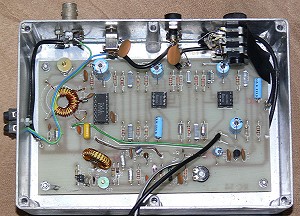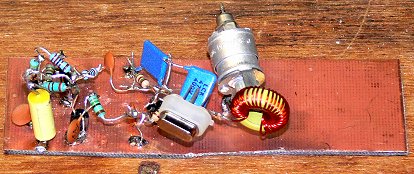The G4FUI RC-14 based Grabber Receiver


The grabber receiver is a home made direct conversion unit, based on the RC-14, a "beginners" project which featured in RadCom in the June 1987 edition. The RadCom project was designed around the then popular Plessey SL6440 IC, and was originally intended as a single band 20m only receiver.
I built my version of the receiver shortly after the article was published, and, like a lot of projects, once it was up and running (it worked adequately well), it was put to one side and almost forgotten.
That was until I was bitten by the "QRSS bug" in 2011, and after running high-specification transceivers for some time as grabbers, I realised that the requirements of a QRSS receiver only really required something much more basic. Once I started this thought process, I first of all considered building a simple receiver which would satisfy these modest requirements, and eventually I remembered that, many years ago, I had already built one which ticked many, if not all of those particular boxes.
That simple receiver was, of course my RC-14. It may not have been the absolute perfect choice, but it seemed like a good starting point.
I realised that the RC-14 could very easily be modified for 30m operation (therefore becoming the RC-10!), and as 30m is probably THE band for QRSS operation, this was the direction I went in at first.
Hans Summers, G0UPL is a good source for parts for QRSS projects at _very_ reasonable prices, and I turned to him for a 10.14MHz crystal, and subsequently the 7.000MHz crystal (see below).
It didn't take long to cobble together a crystal controlled local oscillator to replace the varicap tuned VFO of the origninal, and the RC-10 was quickly pressed into service (QRV, as they say) as a "30m grabber".
One of the problems users of direct coversion receivers have to deal with is that of the opposite-sideband image - not a big problem really, but one of the side-effects of such an image is that a grabber based on such technology will also show signals from the other side of the local oscillator, and, as it happens this is a distinct disadvantage with the QRSS operation on 30m, as the image coincides with other activity, in particular normal propagation beacons. Others have gone to some considerable trouble to remove this image by the clever use of narrow filters tuned to the image frequency, and this is something I will have to consider if I am serious about my 30m grabbing using direct conversion receiver technology. I then decided to experiment with a further conversion to the 40m band by building a 7MHz based local oscillator, and owing to the fact that the QRSS portion of this band is right at the very bottom I discovered, in practice, that the image issue was unimportant as there is no discernable activity at the image frequency!
This appealed to my short-term aspirations and after a few tweaks to the front end of the receiver (it should now be called an RC-7!) it went into service on 40m, and the result has been most satisfactory.

This has proved to be very successful - well successful in that it achieved my own objectives, and now sees regular use pending the rebuilding of the unit into something more sanitary. Frankly it looks a bit of a dog's dinner at the moment, but at least it works!
Careful observers of my screen grabs will have seen on my grabs a steady, almost horizontal line. This appears to be caused a low level spurious signal within my receiver which I haven't as yet been able to track down.
The interesting thing about this signal is that it gives a pretty good indication of the temperature inside the shack. Incidentally the receiver is set up in my garden shack, which is unheated except when I am in there. When the temperature is cold, and by cold I mean zero degrees Celsius(!), the line appears near the top of the screen, and when the temperature is habitable by humans, the line appears near the bottom of the screen. It's totally uncalibrated of course but at least gives one the idea of the temperature in the shed! I have a fancy to re-engineer the receiver at some point, so the spur might disappear, or might get worse, as is the way with these things.